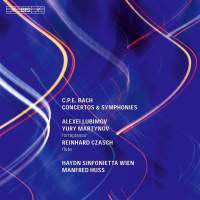Texte paru dans: / Appeared in: |
|
|
|
|
|
Reviewer: Lynn
René Bayley I’m not sure why it is, but as of late BIS recordings of early music on harpsichords and fortepianos tend to sound more distantly recorded than their predecessors, with more “space” around the instruments, which leads to even greater fuzziness of tone. This is certainly the case with the two-harpsichord concerto at the start of this disc. Both Lubimov and Martynov sound as if they are playing excessively fragile, rattly-trap instruments with neither a good tone nor good carrying power, as if they were virginals recorded at a bit of a distance. The orchestra, on the other hand, is nicely recorded with good tone. Conductor Huss adheres to the false religion of straight tone, but at least knows how to play terraced dynamics and injects nice elements of phrasing and shading into his performances. That being said, really none of these performances are must-haves if you already own Miklós Spányi’s superb performance of this concerto with fellow-harpsichordist Cristiano Holtz on BIS 1967, Gustav Leonhardt’s excellent readings of the “Hamburg” Symphonies, and the flute concerto on the Warner Classics boxed set recently reissued and reviewed earlier in this journal. Czasch’s flute playing is pleasant but quite monotonous, no match for Konrad Hünteler on Warner in the same concerto (which, by the way, was also adapted by the composer as a concerto for cello or harpsichord). I would, however, like to toss this little tidbit from the booklet out there for the benefit of all you “historically-informed” folks: When C. P. E. Bach’s “Hamburg” Symphonies were performed in Vienna in 1788, the orchestra contained 80 musicians. Yes, that’s right, 80, not the 30 used on this recording. Get with the plan, Dan: As time marches on, so too does performance practice. This CD concludes with the symphony for double orchestra by C. P. E.’s kid brother, Johann Christian. As the booklet indicates, J. C. Bach’s music was designed more for entertainment than that of his illustrious older brother, and it shows. This is lively, pretty, but inevitably lightweight music, played with zip by the Haydn Sinfonietta but not containing anything particularly memorable or really interesting, although in the first movement I did hear a passage that sounded suspiciously “borrowed” from Gluck’s orchestral introduction to Iphigenie en Tauride. Otherwise, it’s lots of running scale passages alternated with held notes in the winds while the strings play little fliddlybit passages around them. In the second movement Andante, particularly, the non-vibrato sound of the strings really got on my nerves. | |
|
|
|
|
|
|
|
Cliquez l'un ou l'autre
bouton pour découvrir bien d'autres critiques de CD |
|




